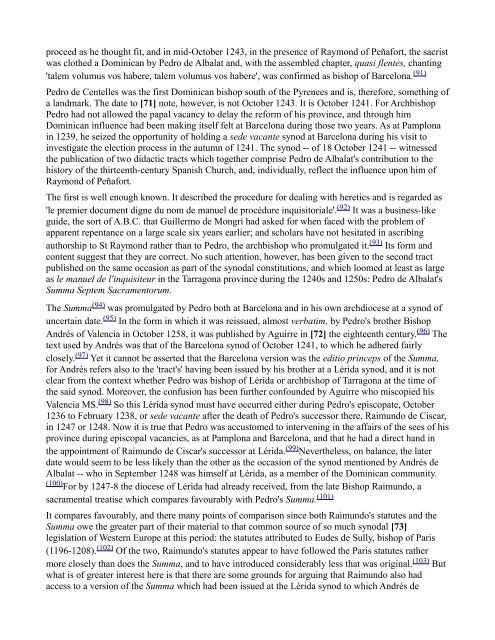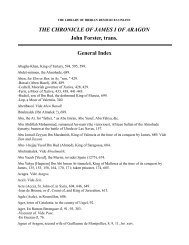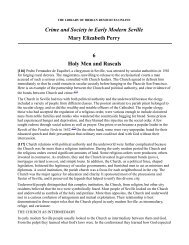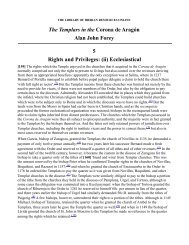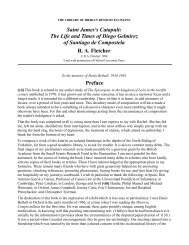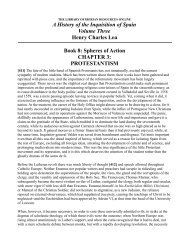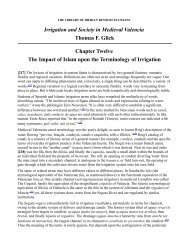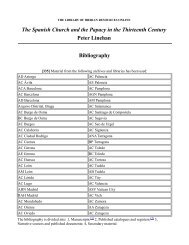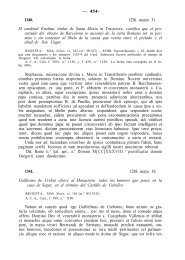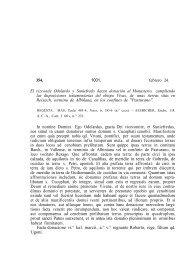Chapter 4 - The Library of Iberian Resources Online
Chapter 4 - The Library of Iberian Resources Online
Chapter 4 - The Library of Iberian Resources Online
You also want an ePaper? Increase the reach of your titles
YUMPU automatically turns print PDFs into web optimized ePapers that Google loves.
proceed as he thought fit, and in mid-October 1243, in the presence <strong>of</strong> Raymond <strong>of</strong> Peñafort, the sacrist<br />
was clothed a Dominican by Pedro de Albalat and, with the assembled chapter, quasi flentes, chanting<br />
'talem volumus vos habere, talem volumus vos habere', was confirmed as bishop <strong>of</strong> Barcelona. (91)<br />
Pedro de Centelles was the first Dominican bishop south <strong>of</strong> the Pyrenees and is, therefore, something <strong>of</strong><br />
a landmark. <strong>The</strong> date to [71] note, however, is not October 1243. It is October 1241. For Archbishop<br />
Pedro had not allowed the papal vacancy to delay the reform <strong>of</strong> his province, and through him<br />
Dominican influence had been making itself felt at Barcelona during those two years. As at Pamplona<br />
in 1239, he seized the opportunity <strong>of</strong> holding a sede vacante synod at Barcelona during his visit to<br />
investigate the election process in the autumn <strong>of</strong> 1241. <strong>The</strong> synod -- <strong>of</strong> 18 October 1241 -- witnessed<br />
the publication <strong>of</strong> two didactic tracts which together comprise Pedro de Albalat's contribution to the<br />
history <strong>of</strong> the thirteenth-century Spanish Church, and, individually, reflect the influence upon him <strong>of</strong><br />
Raymond <strong>of</strong> Peñafort.<br />
<strong>The</strong> first is well enough known. It described the procedure for dealing with heretics and is regarded as<br />
'le premier document digne du nom de manuel de procédure inquisitoriale'. (92) It was a business-like<br />
guide, the sort <strong>of</strong> A.B.C. that Guillermo de Mongrí had asked for when faced with the problem <strong>of</strong><br />
apparent repentance on a large scale six years earlier; and scholars have not hesitated in ascribing<br />
authorship to St Raymond rather than to Pedro, the archbishop who promulgated it. (93) Its form and<br />
content suggest that they are correct. No such attention, however, has been given to the second tract<br />
published on the same occasion as part <strong>of</strong> the synodal constitutions, and which loomed at least as large<br />
as le manuel de l'inquisiteur in the Tarragona province during the 1240s and 1250s: Pedro de Albalat's<br />
Summa Septem Sacramentorum.<br />
<strong>The</strong> Summa (94) was promulgated by Pedro both at Barcelona and in his own archdiocese at a synod <strong>of</strong><br />
uncertain date. (95) In the form in which it was reissued, almost verbatim, by Pedro's brother Bishop<br />
Andrés <strong>of</strong> Valencia in October 1258, it was published by Aguirre in [72] the eighteenth century. (96) <strong>The</strong><br />
text used by Andrés was that <strong>of</strong> the Barcelona synod <strong>of</strong> October 1241, to which he adhered fairly<br />
closely. (97) Yet it cannot be asserted that the Barcelona version was the editio princeps <strong>of</strong> the Summa,<br />
for Andrés refers also to the 'tract's' having been issued by his brother at a Lérida synod, and it is not<br />
clear from the context whether Pedro was bishop <strong>of</strong> Lérida or archbishop <strong>of</strong> Tarragona at the time <strong>of</strong><br />
the said synod. Moreover, the confusion has been further confounded by Aguirre who miscopied his<br />
Valencia MS. (98) So this Lérida synod must have occurred either during Pedro's episcopate, October<br />
1236 to February 1238, or sede vacante after the death <strong>of</strong> Pedro's successor there, Raimundo de Ciscar,<br />
in 1247 or 1248. Now it is true that Pedro was accustomed to intervening in the affairs <strong>of</strong> the sees <strong>of</strong> his<br />
province during episcopal vacancies, as at Pamplona and Barcelona, and that he had a direct hand in<br />
the appointment <strong>of</strong> Raimundo de Ciscar's successor at Lérida. (99) Nevertheless, on balance, the later<br />
date would seem to be less likely than the other as the occasion <strong>of</strong> the synod mentioned by Andrés de<br />
Albalat -- who in September 1248 was himself at Lérida, as a member <strong>of</strong> the Dominican community.<br />
(100) For by 1247-8 the diocese <strong>of</strong> Lérida had already received, from the late Bishop Raimundo, a<br />
sacramental treatise which compares favourably with Pedro's Summa. (101)<br />
It compares favourably, and there many points <strong>of</strong> comparison since both Raimundo's statutes and the<br />
Summa owe the greater part <strong>of</strong> their material to that common source <strong>of</strong> so much synodal [73]<br />
legislation <strong>of</strong> Western Europe at this period: the statutes attributed to Eudes de Sully, bishop <strong>of</strong> Paris<br />
(1196-1208). (102) Of the two, Raimundo's statutes appear to have followed the Paris statutes rather<br />
more closely than does the Summa, and to have introduced considerably less that was original. (103) But<br />
what is <strong>of</strong> greater interest here is that there are some grounds for arguing that Raimundo also had<br />
access to a version <strong>of</strong> the Summa which had been issued at the Lérida synod to which Andrés de


